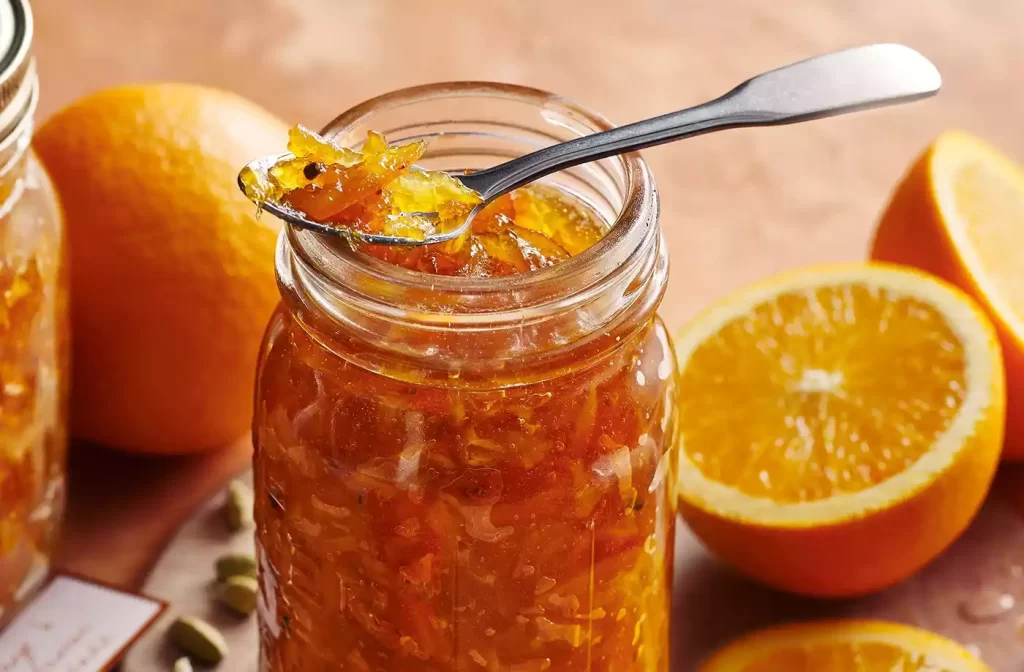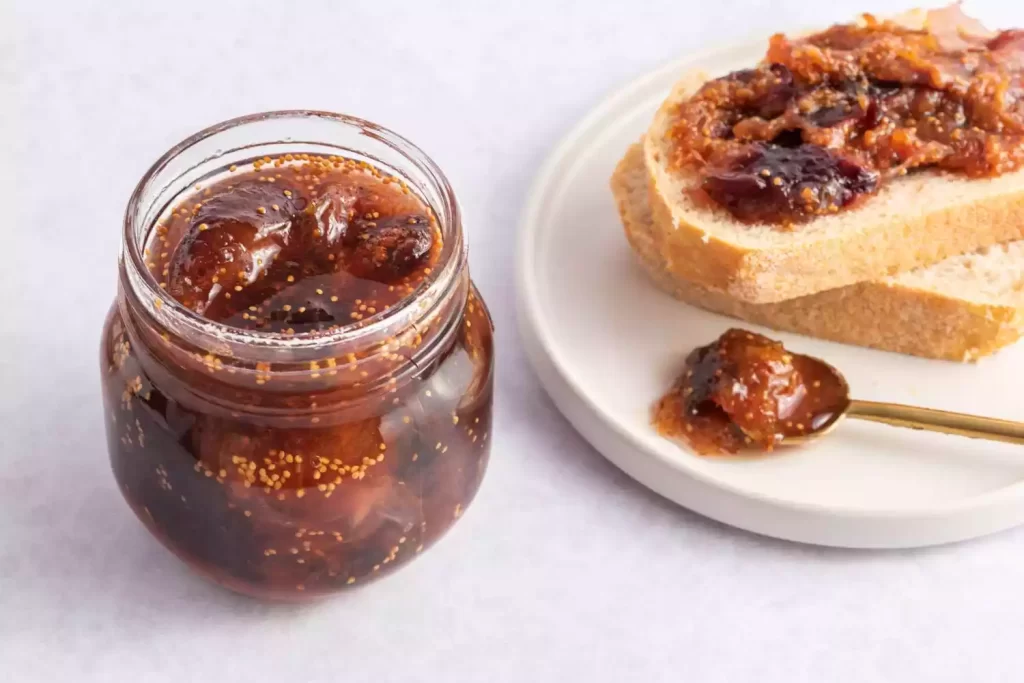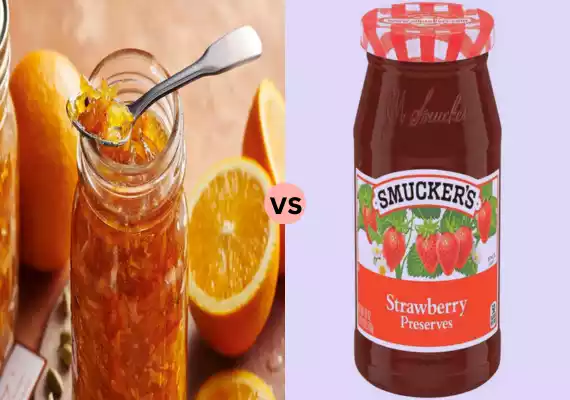The main distinction between marmalade and preserves lies in their fruit content. Marmalades feature finely chopped citrus fruit bits, while preserves showcase larger fruit pieces or whole fruits suspended in a fruit syrup with a jelly-like consistency.
Both marmalade and preserves share common ingredients, including natural acids, pectin, various fruits, and sweeteners like corn syrup, beet sugar, or honey. These delectable spreads are readily available in stores.
It can be homemade, boasting impressive shelf lives when stored under suitable temperature conditions, lasting for months or even years. They serve as versatile accompaniments, enhancing the flavors of toast, desserts, cakes, sandwiches, or biscuits.
What is Marmalade?
Marmalade is a sweet and tangy fruit preserve made from citrus fruits, such as oranges, lemons, or grapefruits. To create marmalade, the fruit is sliced into thin pieces or peel, and then boiled with sugar and sometimes water until it forms a thick, clear, jelly-like consistency.
What sets marmalade apart from other fruit preserves is the inclusion of citrus peel, which adds a delightful bitterness and texture to the spread. This citrusy concoction is a favorite for breakfast, commonly spread on toast or used in pastries.

Marmalade’s unique flavor profile combines sweetness with a zesty tang, making it a versatile ingredient in both sweet and savory dishes. It can also be enjoyed as a condiment with various meats and cheeses.
Plus, the high sugar content in marmalade gives it a longer shelf life, making it a pantry staple. Whether you’re a fan of its distinctive flavor or looking to add a hint of citrus to your recipes, marmalade is a delightful choice.
What are Preserves?
Preserves are a type of fruit spread made by cooking fresh fruits with sugar, which helps preserve their natural flavors and extend their shelf life. Unlike jams and jellies, preserves contain larger chunks of fruit, giving them a thick and chunky texture.
The fruit used in preserves can vary widely, including berries, peaches, or apricots, and the sweetness level depends on the amount of sugar added during the cooking process.

Preserves offer a burst of fruity goodness in every bite, as they retain the distinct taste and texture of the whole fruit. They are commonly enjoyed as a spread on bread, toast, or pastries, making for a delightful breakfast or snack option.
Their traditional uses, preserves are also used as fillings in desserts like cakes, tarts, and cookies, adding a natural fruitiness and sweetness to these treats. Their versatility and wide range of fruit flavors make preserves a pantry staple for many households.
What is the History of Marmalade and Preserves”
Marmalade: Marmalade’s roots can be traced back to ancient Greece and Rome. The word “marmalade” itself is derived from the Portuguese word “marmalade,” which refers to a quince paste.
The practice of preserving quinces with sugar was adapted, and citrus fruits like oranges were used in place of quinces. By the 18th century, marmalade had become a popular spread in Britain, known for its zesty citrus flavor and bitter tang from the peel.
Preserves: Preserving fruits has a history dating back to ancient civilizations who needed to store fruit beyond its natural season. In medieval Europe, fruits were preserved with honey and spices.
As sugar became more accessible, it replaced honey as the primary sweetener. By the 17th century, fruit preserves had become a staple in European kitchens, with a wide variety of fruits being used.
Marmalade vs Preserves: Key Difference
Here’s a comparison chart summarizing the differences between marmalade and preserves:
| Aspect | Marmalade | Preserves |
|---|---|---|
| Fruit Used | Citrus fruits, e.g., oranges, lemons, grapefruits | A wide range of fruits, e.g., berries, peaches, apricots |
| Texture | Clear, jelly-like consistency | Chunky, with visible fruit pieces |
| Flavor | Citrusy, slightly bitter, tangy | Natural fruit sweetness, sometimes with added spices |
| Preparation Process | Boiling fruit and peel, straining | Cooking fruit with sugar, minimal processing |
| Common Uses | Breakfast spread, baking, cooking | Spreading, dessert fillings, culinary applications |
| Shelf Life & Storage | Longer shelf life, store in a cool, dark place | Shorter shelf life, store in the refrigerator after opening |
| Nutritional Differences | Higher sugar content, lower fruit content | Lower sugar content, higher fruit content |
| Popular Variations | Orange, lemon marmalade | Strawberry, raspberry preserves, apricot preserves, and more |
| Vitamin Content | May contain vitamin C | Retains vitamins from the fruit used |
| Fiber Content | Limited fiber due to straining | Higher fiber due to whole fruit pieces |
| Color | Transparent and golden | Varies based on fruit color and variety |
| Bitterness | Slightly bitter due to citrus peel | Typically no bitterness, mostly sweet |
| Traditional Associations | English and Scottish cuisine | Widely used in various cuisines |
How do you make Marmalade and Preserves step by step?
Making process of Marmalade
Step 1: Prepare the Citrus Fruits
- Cleanse your citrus fruit thoroughly.
- Cut them into thin segments or pieces, and then remove seeds.
Step 2: Boil the Fruit and Peel
- Slice the fruit and the peel in an enormous pot filled with water.
- Cook until the fruit is soft and soft and pulpy.
Step 3: Strain the Mixture
- Strain the mixture cooked to separate the peel of the citrus and any remaining solids.
- Conserve the liquid infused with citrus.
Step 4: Add Sweeteners
- Return the liquid that has been strained into the container.
- Use sugar or your preferred sweetener.
- Cook until the mixture gets thicker and becomes a jelly-like substance.
Step 5: Sterilize and Store
- Sterilize the jars, then put them in the hot marmalade.
- The jars should be sealed tightly.
Making processing of Preserves
Step 1: Prepare the Fruit
- Wash, peel, and cut the fruit into desired bits or chunks.
Step 2: Cook the Fruit
- Place the fruits in a pot with sugar.
- Cook on medium temperature, stirring often until the fruit begins to break down and the mixture becomes thicker.
Step 3: Check for Consistency
- To determine whether the preserves are in good condition put a small portion on a plate that has been chilled.
- If it gets wrinkled when you push by a finger, you’re finished.
Step 4: Sterilize and Store
- Sterilize jars.
- Make sure to fill them with hot preserves.
- The jars should be sealed tightly.
- Keep it in the refrigerator following the opening.
Why Some Common Fruits Are Used for Marmalade and Others for Preserves
Marmalade:
- Fruit that is tangy: Marmalade has its distinctive flavor from fruits such as lemons and oranges which are famous for their tartness. The tangy flavor comes from the natural acids present in these fruits.
- Citrus Peel: The thing that makes the marmalade unique is the addition of citrus peels, such as citrus zest or lemon. The peel imparts a distinctive and slightly bitter taste to the spread that creates a balance of tangy and sweet flavor.
- Zesty Delight: People who appreciate the citrus fruit’s zing typically love marmalade due to its refreshing, slightly tart and refreshing taste. The bitterness of the peel can add depth to the flavor of the flavor.
Preserves:
- Sweet and Multi-purpose: Fruits like strawberries as well as peaches and apricots have a natural sweetness. They don’t possess the same bitter or tangy characteristics as citrus fruits, which makes them great for making preserves.
- Whole Fruit In making preserves it is important to preserve the sweetness and flavor of the entire fruit. This is why you’ll notice visible pieces or chunks of fruit inside preserves, showing their natural sweetness.
- Variety of flavors: The wide range of fruit that can be used in preserves can provide a variety of flavors and sweet levels according to the fruits that is used. It’s the natural sweetness that people love preserved foods.
What Distinguishes Marmalade from Preserves?
Marmalade and preserves are both delicious fruit-based spreads, but they have distinct characteristics that set them apart:
- Fruit and Peel: Marmalade is primarily made from citrus fruits like oranges, lemons, or grapefruits, often including the peel for a hint of bitterness. Preserves, on the other hand, use a wide range of fruits like berries or peaches and typically don’t include peel.
- Texture: Marmalade has a clear, jelly-like consistency, while preserves are chunkier, with visible pieces of fruit.
- Flavor: Marmalade offers a tangy and citrusy flavor, with a slight bitterness from the peel. Preserves retain the natural sweetness of the fruit, sometimes enhanced with added spices.
- Preparation: Marmalade involves boiling fruit and peeling and then straining, while preserves are made by cooking fruit with sugar with minimal processing.
- Uses: Marmalade is commonly a breakfast spread, while preserves are more versatile and suitable for spreading and as dessert fillings.
How long can you keep Marmalade and Preserves?
The shelf life of marmalade as well as preserves is determined by the way the items are kept. Jars that are not opened of preserves and marmalade will typically last about 1 year if kept in a dark, cool space. But once they are opened their shelf lives decrease drastically.
Marmalade due to the higher amount of sugar will last longer upon opening. It can be stored in the fridge for as long as 6 months. Preserves, with low sugar content, can only last for a period of 1 to 3 weeks in the fridge.
To keep the shelf life as long as possible It is essential to ensure that the jars are sealed, and then refrigerate them immediately following opening. Examine for signs of spoilage such as smells or mold, and throw them out if you find any. A proper storage system and handling are crucial to enjoying the delicious flavor of preserves and marmalade.
What are the Health Benefits of Marmalade and Preserves?
Health Benefits of Marmalade and Preserves:
- Rich in Vitamins: Both marmalade and preserves retain the vitamins present in the fruits used. They can be a good source of vitamin C and other essential nutrients, contributing to overall health.
- Fiber Content: These spreads contain dietary fiber, which supports digestive health and can help regulate blood sugar levels.
- Antioxidants: Fruits used in marmalade and preserves are packed with antioxidants that combat free radicals, potentially reducing the risk of chronic diseases.
- Natural Sweetness: Using less sugar in homemade versions can make these spreads a healthier alternative to overly sweet commercial products.
- Versatility in Meals: They can be used in various dishes, adding flavor and nutrition to your diet, such as in desserts, sauces, and glazes.
Summary
Preserves are fruit spreads made by cooking fresh fruit with sugar to preserve their natural flavors and extend shelf life. They feature larger fruit chunks, creating a thick, chunky texture. Common fruits used include berries, peaches, and apricots.
Preserves are enjoyed as spreads on bread, toast, or pastries, offering a burst of natural fruit goodness. They’re also used as fillings in desserts like cakes and tarts, enhancing their flavor and sweetness. Versatile and available in a variety of fruit flavors, preserves are a pantry essential for many households.

